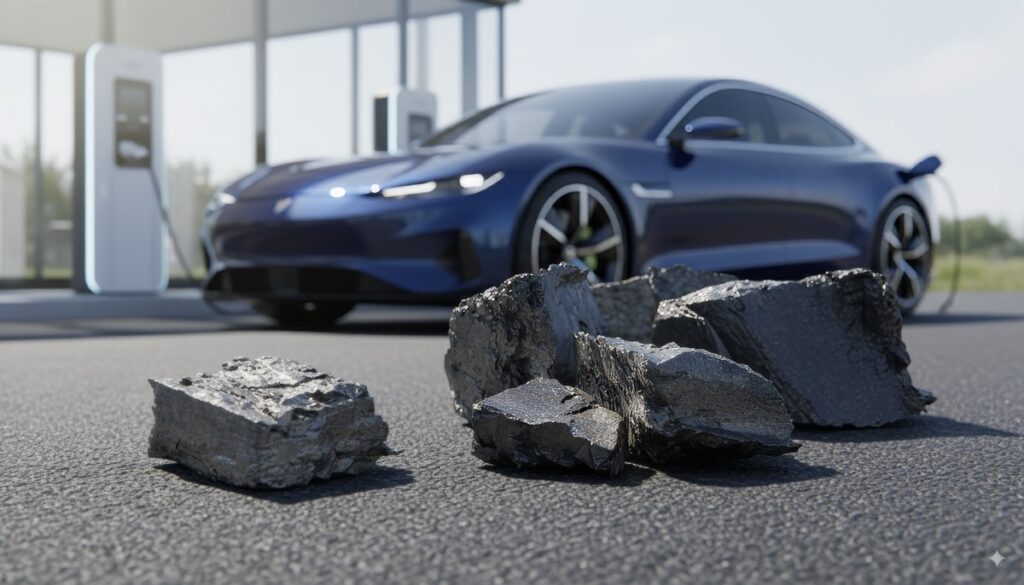Rare earths, those obscure elements with names like neodymium, dysprosium, and terbium, sit quietly at the heart of modern life. They make the magnets in our phones and the powerful motors in electric vehicles. Without them, the global shift to clean energy slows to a crawl. And the world has a problem, because these metals are rare in more than name.
For decades, more than two thirds of the world’s supply has come from a single country, China. For the heavy rare earths such as dysprosium and terbium, which let EV motors survive punishing heat, China’s dominance is close to a monopoly. When Beijing briefly restricted exports in the past, Japanese manufacturers like Suzuki had to halt production lines. Economists call that a supply shock. Policymakers call it a national security risk.
The numbers are daunting. Demand for permanent magnets is expected to triple within a decade. By 2035, consumption of rare earths for magnets could reach 176,000 tons a year, with a shortfall of about 60,000 tons, roughly thirty percent of expected demand. Prices lurch in response, pushed around by geopolitics and speculation.
In theory, recycling could help. In practice, it barely exists. Today, less than one percent of rare earths are recovered. The reason is practical rather than mysterious. The process is slow and costly. A used motor must be taken apart by hand, its magnets heated to 350 to 500 degrees Celsius to demagnetize them, then pried out piece by piece. One motor can eat up two hours of labor, which is an eternity on an assembly line.
Game-Changer One: Melting the Problem Away
An unlikely duo, Nissan Motor and Waseda University, has flipped the logic. Why dismantle a motor if you can melt it whole?
Their pyrometallurgical method feeds the entire motor into a furnace with carbon, iron, and a borate flux. Above 1,400 degrees Celsius, everything liquefies and separates into two layers, a dense iron–carbon alloy at the bottom and a lighter slag rich in rare-earth oxides on top. From that slag, rare earths can be recovered with about 98 percent efficiency. Because disassembly and demagnetization disappear, total processing time is cut roughly in half.
This is industrial alchemy with a practical aim, scale. What once felt like an artisanal chore can become an automated flow. If commercialization holds, discarded EVs and retired wind turbines turn into an above-ground mine.
Game-Changer Two: Not Using Them at All
Recycling is only half the story. Another thread of Japanese ingenuity asks a sharper question, what if we remove rare earths from the equation altogether?
In Kyoto, a start-up called Next Core Technologies has developed a metallic ribbon about thirty microns thick, nicknamed Helmet. Built into a motor, it suppresses heat so effectively that the usual heavy rare earths, added to keep magnets stable at high temperature, are no longer needed. The ripple effects are large, less exposure to China’s export leverage, a potential cut in energy use of up to fifty percent, and more driving range for EVs. Around thirty companies, from automakers to appliance makers, are already testing prototypes.
Nissan has also started deploying magnet-free motors in its Ariya EVs. The strategy is deliberately two pronged, recycle where you can, redesign where you must.
Rethinking the Supply Chain
Together, these approaches signal a challenge to the very architecture of the rare-earth supply chain. They promise:
-
Independence from chokepoints. Motors that withstand heat without heavy rare earths weaken China’s monopoly grip.
-
Stability in cost. Freeing manufacturers from volatile commodity markets smooths price shocks.
-
Performance gains. Less heat means greater efficiency, extending the range of EVs.
-
Speed. Recycling and non-rare-earth designs can be deployed faster than opening new mines, with far less ecological cost.
Two Roads, One Destination
One road leads to recovery, melting old motors to reclaim scarce metals. The other leads to redesign, building motors that never needed those metals in the first place. Both roads run through Japan. Both aim at the same horizon, a future where high technology is less vulnerable to resource politics.
Over the next decade, the map of electric mobility may be redrawn. At the center may not be new mines in distant places, but a set of simple, radical ideas conceived in Japanese labs that dared to flip the script.
Reference: “Japan’s Strategy for Rare Earths,” Science Portal, JST (2022).
I hadn’t felt a spark from Nissan in years. Most of the headlines were grim. Factory closures. Shrinking lineups. Talk of survival by cutting back. It felt like a company waiting to fade. Then a story arrived that stirred me again. Against the headwind, something of Nissan’s old engineering spirit was still alive.
The world cannot stop talking about rare earths. They are the quiet bones of modern life, inside our phones and inside the motors that push electric cars down the road. The rare-earth problem is not Japan’s alone. It is global, and it is geopolitical. Nearly three quarters of the supply comes from China, which means Beijing holds leverage over manufacturers in Detroit, Tokyo, Stuttgart, and everywhere in between.
No one is untouched. The United States may feel it most, a country that wants to act tough yet knows the other side holds the rare-earth card. Tariff battles flare and fade, but the ricochet hits someone else while China barely flinches.
That is why Nissan’s move caught my eye, a motor that does not lean on permanent magnets. In the Ariya crossover, Nissan uses an electrically excited synchronous motor (EESM). Instead of rare-earth magnets, coils of copper wire create the magnetic field. No neodymium. No dysprosium. None of the heavy rare earths that keep automakers tied to China. In plain terms, it sketches a future with fewer resource chains.
Nissan has not stopped there. The company has been working to give back what it takes. It already cut its rare-earth needs in past models. Now, working with a university, it is testing a recycling process that recovers rare earths from used motors with striking efficiency. You cannot brag about it in a showroom, yet it is the kind of quiet groundwork that lets an industry sleep at night. It looks modest, but it can change the game.
Nothing about this is easy. A new round of export controls from China can still throw production plans into chaos. Sourcing parts remains a tug of war. But pair a magnet-free drive with a loop that recycles what has already been mined, attack and defense side by side, and you have a hand you can play even in a storm.
American firms are racing to rebuild mines and magnet factories at home. Refining is another matter, where China still holds an edge. That is why Nissan’s three-beat rhythm feels right to me: do not use when you can redesign, use less when you must, and give back whenever possible. It sounds like a chorus the whole industry could be singing soon.
I want Nissan to keep walking this path. Not chasing flashy one-offs, but renewing its foundations step by step, quietly strengthening the future of cars and propping up the industry as an unsung backbone. Taken on by today’s Nissan, that role feels especially meaningful.
And I hope the shine returns. May they surprise us again with legends like the Bluebird, the Skyline, the Fairlady Z, and the GT-R..


